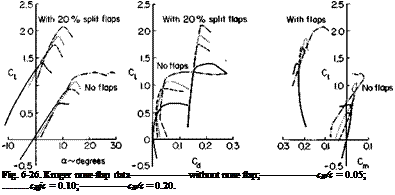Nose Flaps
Nose flaps are probably not so important to V/STOL applications as trailing edge flaps, for they appear to be advantageous only to thin sections used for high-speed applications. High-speed V/STOL applications will probably depend on direct-lift engines or fans-in-wing for their high lift. Nevertheless, for completeness some discussion of nose flaps is warranted.
 |
Two forms have been developed, the Kruger flap and the plain leading – edge flap. Kruger’s nose flap is hinged at the leading edge and rotates out from under the wing to an optimum position of about 130°. The Kruger flap has no marked effect at angles of attack below the stall, but rather it prolongs the lift curve and delays the stall for several degrees. Figure 6-26 presents some data on this type of flap obtained from Ref. 1.
The plain leading-edge flap appears to have the advantage over the Kruger flap in that its geometry can be varied in a more continuous manner. Hence increments in lift, drag, and pitching moment would take place in a continuous manner and not in a sudden jump, as with the Kruger flap. A variety of settings, coupled with the trailing-edge flaps, can be used to provide a variable camber wing. Tests made at RAE of a 20% c leading – edge flap and a 7^% thick bi-convex section with the flap down about 30° showed an increase in CL of about 0.4.
"max











